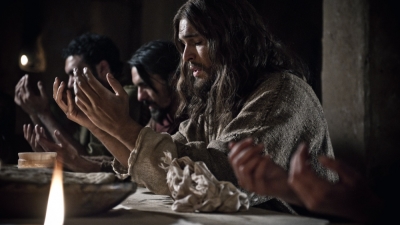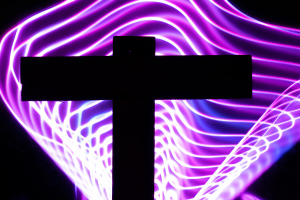The Lord’s Supper now!

Eating food is a formidable factor in our lives – physically and spiritually. How we eat can help us maximize our achievements, benefit our health, or enhance our sleep. In other ways, eating can dull our senses, damage our health, and destroy our sleep. Fasting can be spiritually potent – but also feasting can be spiritually moving. Both are endorsed in our Scriptures, at the proper times. But the Lord’s Supper is attractive food that is transformative.
Jesus instituting the Lord’s Supper is a life-changing narrative. Over time there have been many theories of the Lord’s Supper’s meaning – but I still find it uniquely helpful and delightful to return to the simple original ancient story, so accessible – such as in Luke 22:7-22.
In the vibrant evangelical movement in which I was raised, the Bread and the Cup were constantly referenced as “mere symbols” of Jesus’ body and blood. However, in my youth I saw a huge problem with that interpretation. A “mere symbol” is a contradiction in terms, since true symbols are powerful and they engage directly what they symbolize. Better terms would have been “vibrant symbols,” or “transformative symbols.” In contrast, our Roman Catholic neighbors affirm that through the prayers of an ordained priest the bread is transubstantiated into the Body of Christ and the wine is transubstantiated into the Blood of Christ. Consequently, those items are no longer bread or wine – in spite of their appearances. The Scriptures do not require such metaphysics, and transubstantiation is quite a strain to believe.
Other positions for interpreting the Lord’s Supper include “consubstantiation,” where, with the right prayer, the bread and wine become the literal Body and Blood of Christ while remaining bread and wine. There is also the “real presence” interpretation, where prayers of the clergy bring Christ’s spiritual presence into the celebrative event of the Lord’s Supper. All these theories are used for institutionalizing one of the greatest stories – and such institutionalizing has its place.
However, providentially we still have the very ancient stories of Jesus transforming Passover meal into the Lord’s Supper. The roots in Passover are significant – (1) because Jesus repeatedly overtly references Passover, (2) because Jesus was also committed to being the Bloody Ultimate Passover Lamb the very next day, and (3) because Jesus’ painful work on Calvary was all about holistic liberation, redemption, and reconciliation – as was the first Passover. The new Passover meal includes the living presence of the Passover Lamb who was slain and lives forever, along with Bread and a Cup of wine or juice representing his gifts of grace – his Body and his Blood.
In contrast, the Old Passover meal no longer exists! Since the destruction of the Temple in A.D. 70, there is no lamb present in current Jewish Passover meal, even though a roasted male lamb was central to the original Passover. Now, instead there is only a roasted meatless lamb shank bone on each plate along with a variety of bitter herbs and possibly some chicken or fish. The bare lamb bone, called the zeroah, is there to help participants remember what was lost in A.D. 70. However, in the New Passover meal nothing is lost because the Living Lamb is present as the true Lord of his Supper.
As we go back to reread the ancient story, its beauty and relevance fittingly grab our attention. “This is my body. It is given for you.” Jesus said. “Every time you eat it, do this in memory of me.” Different churches have preferences in their interpretations and styles of their formal reproduction of this event, as we have seen. At the same time, Jesus himself invites us to join him in his narrative in our personal lives, too. All pieces of Bread that we receive and eat, we can receive and eat as gifts of the Lamb of God’s real presence and amazing grace. The gift of Bread as Jesus’ body is such a stunning revelation – that when he adds that we should always eat Bread “in remembrance” of him, the point is almost redundant. Jesus’ gracious gift is so memorable, we should think of Jesus every time we see a piece of Bread!
As you know, Jesus’ links with Bread and the Cup are well established. He is the Manna from heaven (John 6:58), and he called himself the Living Bread (John 6:51) the Bread of Life (John 6:53, 48), and Jesus holds Bread and everything else together by his powerful Word (Hebrews 1:3). Jesus also compared himself to a wheat grain that dies in order to multiply for the bread for many people. Jesus is also the living water (John 4:14; 7:37-39), and the new wine. Moreover, from the beginning, Jesus is the Cosmic Glue, because “in him all things hold together” (Colossians 1:17). The Bread is Bread because of Jesus’ authority, and the Cup and its contents are possible only because Jesus holds them together. With his intimate grace-filled presence within everything in our daily lives, surely we can remember Jesuswith thanks whenever we eat Bread or drink a Cup of wine or juice.
Does institutionalizing the Lord’s Supper take it out of our hands? In general, does institutionalization eliminate individual opportunity and responsibility? Consider if you joined the Red Cross, took its first-responder training and skillfully participated in its volunteer programs. Would that preclude you from giving first-responder aid for your family, friends, neighbors, or in travel even thousands of miles away? Of course not! Your institutional training and participation would only add quality and support for your first-responder service anywhere.
Similarly, is it OK that Churches have institutionalized the Lord’s Supper with their divergent theories and articulated formalities? Yes, and enjoy and celebrate with them as God leads you. But is it OK to see Jesus in the Bread and Cup at home or in a restaurant or at a party? Yes, because the original primal story still stands, and it is ours to joyfully read and affirm. Jesus still says with the Bread, “This is my body. It is given for you. Every time you eat it, do this in memory of me.”Jesus is still in the Bread as he is also in the Cup and every blessing. Our Lord Jesus Christ remains the huge, vibrant intersection of time and eternity where we live – both for our Churches and for ourselves.
So experience and celebrate the Lord’s grace, presence, liberation, redemption, and reconciliation in the New Passover, the Lord’s Supper – at both Church and wherever you recognize the vibrant Bread and Cup of the Lord.
Paul de Vries, pauldevries.com, is the president of New York Divinity School, and a pastor, author, and speaker. Dr. de Vries is a specialist in Biblical hermeneutics and ethics, and he is a life-long advocate for Biblical Activism.



























